Last updated: January 25, 2025
The Stations of the Cross, also known as the Way of the Cross or the Via Dolorosa, originated from the design of pilgrimages that were wildly popular in the Middle Ages. Many pilgrims to Jerusalem wanted to literally follow the footsteps of Jesus as he walked to his crucifixion. During the 13th century, the Franciscan order became caretakers of the Christian holy sites, and the earliest use of the word “stations” to describe this Way of the Cross occured in the narrative of an English pilgrim, William Wey, who visited the Holy Land in the mid-15th century. Later in the 15th and 16th centuries, the Franciscans built outdoor shrines in Europe to support reflection on the Passion of Christ, which is the story of the arrest and crucifixion of Jesus. In 1636, they gained permission from Pope Innocent XI to move the stations inside churches and they became more widely utilized.
Today pretty much all Catholic churches include representations of the fourteen stations. These are used during Lenten devotions, sometimes every Friday during Lent and always on Good Friday. Traditionally, the Stations of the Cross ritual is a physical devotion, involving standing, kneeling and genuflections or movement as a congregation around the stations. I have vivid memories from my childhood of attending the “old school” Stations of the Cross on Good Friday, where you stand and kneel, stand and kneel and genuflect, etc. and then repeat. The fourteen Stations of the Cross are closely associated with the Lenten theme of repentance, but modern interpretations tend to be a little less obsessed with sin and personal penitence.
Here, I present a description of the fourteen stations, references to applicable gospel passages, some of my own comments, and some questions for reflection. I have chosen artwork in stark, dramatic black and white to illustrate each station. As I write this blog post, I observe myself using the words “must have been” quite alot. I think maybe that is just the point of the Stations of the Cross. They ask us to imagine the cruelty of the dehumanizing crucifixion sequence. In addition, observing the Way of the Cross can lead us to reflect on how we face difficulties and how we are not alone, even in our darkest hours.
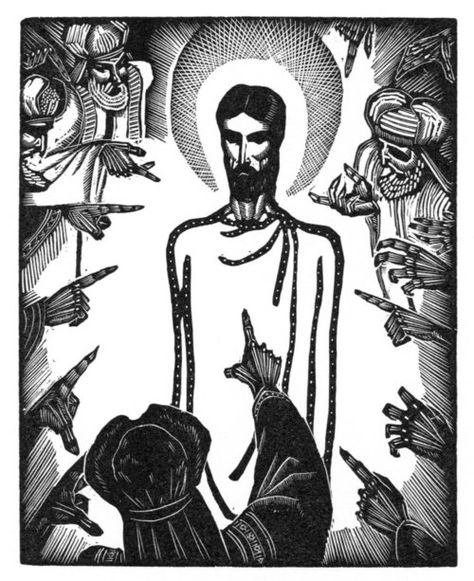
We adore you, O Christ, and we praise you. Because by your holy cross, you have redeemed the world.
I. Jesus is condemned to death.
When the chief priests and the Temple guards saw Jesus, they shouted, “Crucify him! Crucify him!” Pilate told them, “Do it yourself. I find no reason to condemn him.” “We have the law,” the Temple authorities replied, “that says he ought to die because he claimed to be the Only Begotten of God.” When Pilate heard this, he was even more afraid. He went back into the Praetorium and asked Jesus, “Where do you come from?” Jesus didn’t answer. Then Pilate said to Jesus, “You refuse to speak? Bear in mind that I have the power to release you – and the power to crucify you.” “You would have no authority over me,” Jesus replied, “unless it had been given to you by God. Therefore the person who handed me over to you has the greater sin.” Upon hearing this, Pilate attempted to set Jesus free. But the crowd shouted, “If you set him free, you are no ‘friend of Caesar.’ Anyone who claims to be king defies Caesar!” Hearing these words, Pilate took Jesus outside and seated himself on the Judge’s seat at the place called the Pavement, “Gabbatha” in Hebrew. Now it was almost noon on Preparation Day for the Passover. Pilate said to the people, “Here is your king!” “Take him away!” they shouted. “Take him away! Crucify him!” Pilate asked, “Do you want me to crucify your king?” The chief priests said, “We have no king but Caesar!” Then Pilate handed Jesus over to them to be crucified. (John 19:6-16)

I really like the drama of this image of the first station and Jesus’ radiance and calm presence. With all of the circus surrounding his arrest by the Sanhedrin, questioning under Caiphas, Pontius Pilate, and Herod, he was accused and condemned on all sides by leaders who felt insecure, jealous, and threatened. Yet Jesus was somehow able to keep his composure, under duress. It seems that sometimes silence is the only answer, and Jesus remained silent. He was sentenced to die because he defied both state and religious authorities, preaching the Good News that demanded a conversion process that they were unwilling to consider.
What about us? Are we willing to open our eyes to the truth? What injustices are we willing to stand up against?
II. Jesus picks up his cross.
The soldiers led Jesus away into the hall known as the Praetorium, then they assembled the whole battalion. They dressed Jesus in royal purple, then wove a crown of thorns and put it on him. They began to salute him , “All hail! King of the Jews!” They kept striking Jesus on the head with a reed, spitting at him and kneeling in front of him, pretending to pay homage. When they had finished mocking him, they stripped him of the purple and dressed him in his own clothes. Then they led him out to be crucified. (Mark 15:16-20)
The second station of the cross reminds us that our choices have consequences and that true commitment to doing what must be done can bring pain. Jesus did not run away from the outcome of the way he had led his life. Instead, he picked up his cross and faced his fate with dignity.
When we begin a new spiritual practice or volunteer project, do we have the perseverence to see it through to completion? Have there been times when we have faced painful consequences when standing up for what is right?
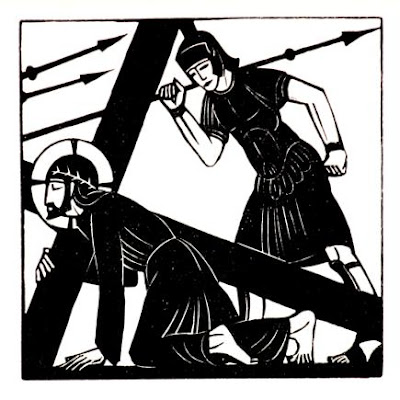
III. Jesus falls the first time.
There is no scriptural basis or description of Jesus falling as he carries his cross to the crucifixion site, Golgotha. Nevertheless, it makes sense that he was struggling and physically dragging the cross, especially since he had been whipped, mocked, and severely beaten before he was released to be crucified. However, most importantly, when Jesus fell, he dug deep and refused to quit. He could have refused to go any farther, and the soldiers could have dragged him and the cross on to the crucifixion location. Jesus models for us that things that are important in life are worth standing up for.
How do we face extreme physical or emotional pain? Do we keep walking forward or do we just give up?
IV. Jesus meets his mother.
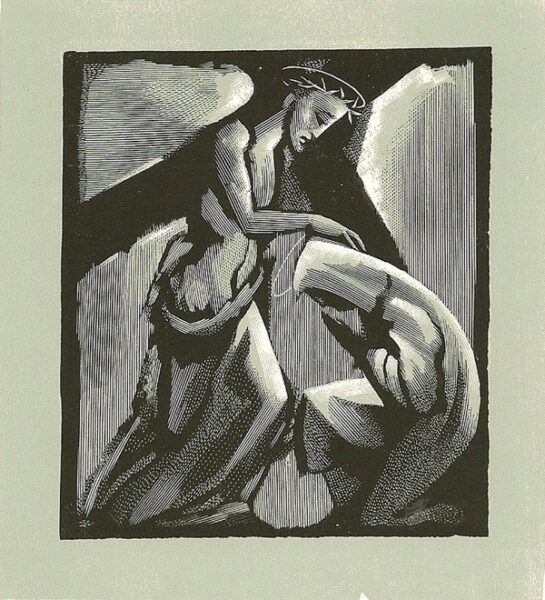
There is no mention in the gospels of Jesus meeting his mother on the Way of the Cross. However, there is this well-known story in the gospel of John that chronologically follows the eleventh station:
Standing close to Jesus’ cross was his mother, his mother’s sister, Mary, the wife of Clopas, and Mary of Magdala. When Jesus saw his mother and the disciple whom he loved standing there, he said to his mother, “Here is your son.” Then he said to his disciple, “Here is your mother.” From that moment, the disciple took her into his household. (John 19:25-27)
No matter when they met in the process of the crucifixion, both Jesus and his mother Mary must have been heartbroken by the situation. Also, in the presence of such extreme violence, saying goodbye to each other in public surely must have been so awful and soul-crushing. At least, in the three verses above from the gospel of John, Jesus is able to explicitly establish an enduring bond and connection between his mother and the disciple Jesus loved, for them to be committed to each other going forward. Jesus needed to know that his mother would be taken care of. But truly, Mary must have been devastated to see her son in such pain and anguish. Still, she loved him strongly and respected him enough not ask him to change on her behalf.
How do we love our families and friends? Do we trust them, respect their individuality, and honor the place of God in their lives?

V. Simon of Cyrene helps Jesus carry his cross.
As they led Jesus away, they seized Simon – a Cyrenean who was just coming in from the fields – and forced him to carry the cross behind Jesus. (Luke 23:26)
We don’t know very much about Simon of Cyrene. According to the gospels, he seems to just be a person who was in the wrong place at the wrong time and was pressed into service to help Jesus carry the cross. In the gospel of Mark, Simon is identified as “the father of Alexander and Rufus.” The inclusion of this detail may indicate that Simon’s sons became Christian missionaries or had some standing in the early Christian community in Rome. Sometimes we consciously intervene to help others who suffer, but sometimes, like Simon, we become inadvertently involved.
Who around us now are suffering and in need of comfort or assistance? How can we discover in helping others that we ourselves grow in the process?
VI. Veronica wipes the face of Jesus.
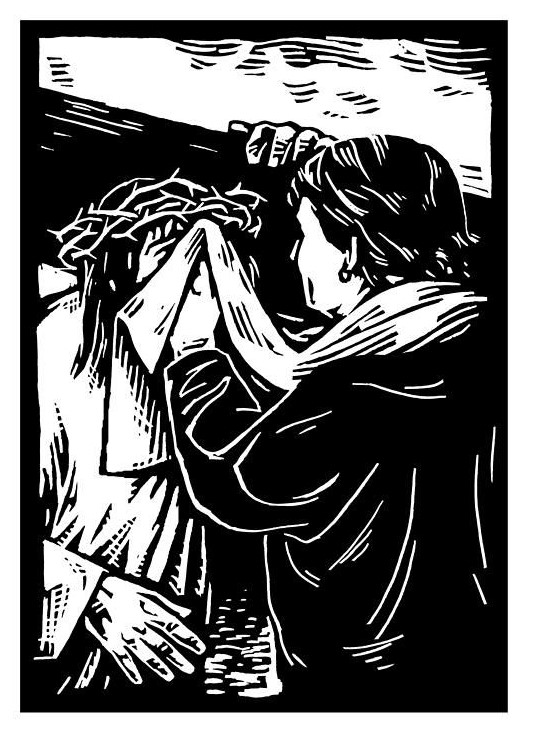
According to the Stations of the Cross, Veronica, courageously appeared out of the crowd, met Jesus on his way, and was kind enough to wipe his face that must have been covered in sweat, dirt, and blood. There is no scriptural story for this meeting between Jesus and Veronica, but there is a church tradition that an image of his face was transferred to the cloth Veronica used. There are many religious paintings that depict Veronica with the cloth showing Jesus’ image imprinted on it. If the meeting did take place, this merciful kindness to Jesus must have been greatly appreciated.
How can we turn our convictions against injustice into tangible acts of mercy? Who in our community are in need of our mercy and forgiveness?

VII. Jesus falls the second time.
Again, there is no scriptural basis or description of Jesus falling as he carries his cross to Golgotha, where he was crucified. Nevertheless, it makes sense that progress was slow, under the weight of the cross, even though Simon of Cyrene was helping him to carry it. The repetition of falling in the Stations of the Cross emphasizes the drama and agony of the walk to the crucifixion.
What obstacles or fears are we trying to avoid? How can we face our fear and summon the strength to do what we think we cannot do?
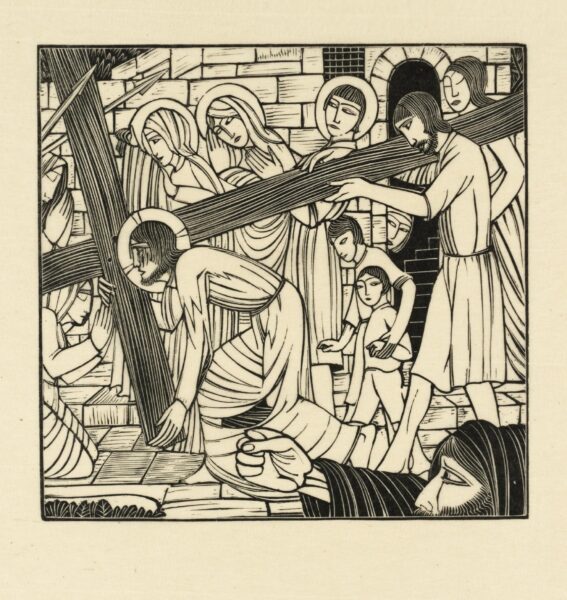
VIII. Jesus meets the women of Jerusalem.
A large crowd was following, many of them women who were beating their breasts and wailing for him. At one point, Jesus turned to the women and said, “Daughters of Jerusalem, don’t weep for me! Weep rather for yourselves and your children! The time is coming when it will be said, ‘Blessed are the childless, the wombs that have never given birth and the breasts that have never nursed.’ Then people will say to the mountains, ‘Fall on us!’ and to the hills, ‘Cover us up!’ For if they do these things when the wood is green, what will happen when it is dry?” (Luke 23:27-31)
In this image, the women of Jerusalem are behind him, and he turns to address them, telling them to weep for themselves and their children rather than for him. This reading shows that, even in his pain and agony, Jesus was still thinking of others. This address of Jesus to the women of Jerusalem is widely thought to foreshadow the destruction of Jerusalem that occurred within a few decades after the death and resurrection of Jesus.
In what circumstances do we pay attention to others and when are the times when we are we more self-absorbed? Are we willing to open our eyes to the suffering of others?
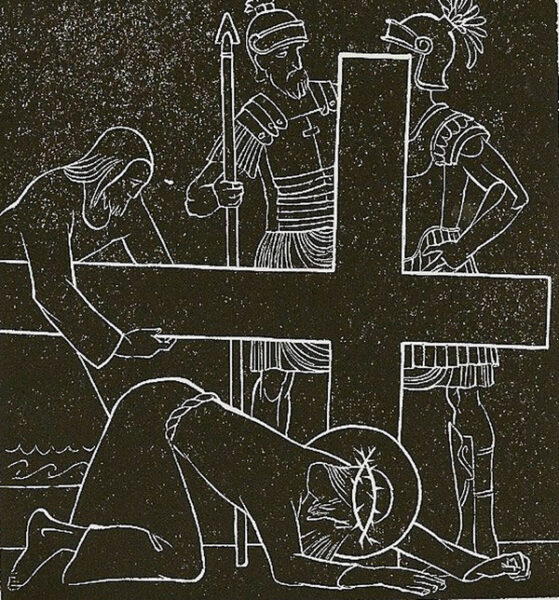
IX. Jesus falls the third time.
Again, the gospels don’t provide any description of Jesus falling as he carries his cross to Golgotha, which means Skull Place. Nevertheless, it makes sense that, even with help from Simon the Cyrene, he continued struggling. The repetition of yet a third falling allows us to imagine (again) how difficult this Way of the Cross must have been. Yet Jesus gets up and keeps pressing on. This third repetition is reminiscent of the three times during the Agony in the Garden that Jesus rebuked his disciples for falling asleep and the three times that Peter denied knowing Jesus and the three times that Pilate told the crowd that he found Jesus to be innocent. Repetition is clearly used for emphasis.
How do we react when faced with repetitive failure? What situations are we in that require us to get up and begin again?
X. Jesus has his clothes taken away.
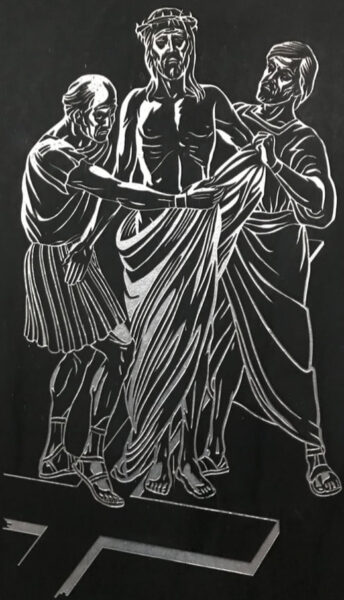
After the soldiers had crucified Jesus, they took his clothing and divided it into four pieces, one piece for each soldier. They also took the seamless robe. The soldiers said to one another, “Let’s not tear it. We can throw dice to see who will get it.” This happened in order to fulfill the scripture, “They divided my garments among them and, for my clothing, they cast lots.” And this is what they did. (John 19:23-24)
Everything was taken from Jesus, even his clothing, in this final, complete humiliation and loss of possessions. If you take away all that one owns, it seems really the very last thing one has in life is one’s clothing. Yet even this was taken. These details in the passion sequence also act as a mechanism to highlight the fulfillment of the Old Testament prophesies. Still, this action to humiliate and degrade Jesus brings emptiness and sorrow. Here is Jesus, standing at the threshold of his life, emptying himself for others. Perhaps, as written by Christin Lore Weber, “ebbing is the power opening the passage through which life flows. Perhaps, paradoxically, emptying is fullness.”
In what ways are we called to empty ourselves, in order to be ready to receive new life? Below all the masks and outward appearances, aside from all of our possessions, deep within our inner lives, how do we define our identity and rootedness in God?

XI. Jesus is nailed to the cross.
There is no detailed description of the horror of Jesus being nailed to the cross, and in the gospels of Matthew and Mark, it is almost casually noted. Matthew 27:35-36 states that after he was nailed to the cross, the soldiers divided his clothing and sat down to keep watch 0ver him. This was established in the older synoptic gospel – Mark 15:24-25 which also adds the detail that Jesus was nailed to the cross at around 9 am.
What I like about this image for the eleventh station is that Jesus appears absolutely terrified! We know that Jesus was fully human and remember the stories of how he was tempted in the desert, about how he was so angry that he threw the money changers out of the temple, and that he cried when his friend Lazarus died. However, before seeing this image, I had never considered that Jesus might have been afraid at any point in his arrest and crucifixion. But being frightened is an extremely human condition, and so this image really speaks to me of his fear and confusion, his vulnerability and humanity.
How can we make sure that our search for the greater good is monumental enough to be worth risking the potential for pain and fear? And then, what processes do we use to help manage the extreme, inevitable pain and fear, during our times of personal crises/crosses?
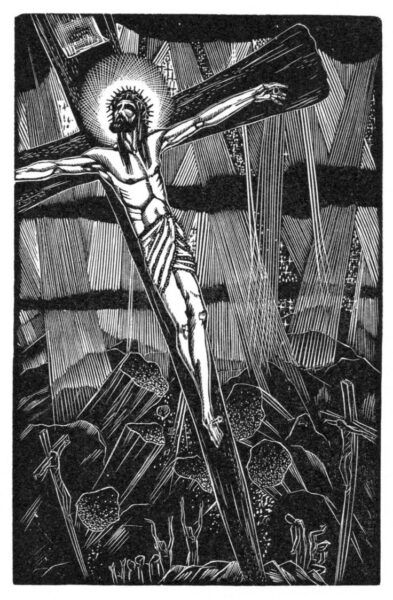
XII. Jesus dies on the cross.
At noon, a darkness fell over the whole land until about three in the afternoon. At that hour, Jesus cried out with a loud voice, “Eli Eli, lama sabachthani”‘ which means “My God, My God, Why have you forsaken me?” This made some of the bystanders who heard it remark, “He is calling for Elijah!” One of them hurried off and got a sponge. He soaked the sponge in cheap wine and, sticking it on a reed, tried to make Jesus drink. The others said, “Leave him alone. Let’s see whether Elijah comes to his rescue.” Once again, Jesus cried out in a loud voice, then he gave up his spirit. Suddenly, the curtain in front of the Holy of Holies was ripped in half from top to bottom. The earth quaked, boulders were split, and tombs were opened. Many bodies of holy ones who had fallen asleep were raised.” (Matthew 27:45-52)
So in the end, Jesus succumbs to the violence, and darkness falls. The account in Luke 23:44-46 indicates that the last words of Jesus were “Abba, into your hands I commit my spirit.” And in John 19:28-30, his last recorded words were “It is finished” before he bowed his head and “gave up his spirit.” Now is the time of death. Maybe Jesus could face this ultimate, physical death because of his faith in God and the wisdom he gained from the little deaths he confronted during his lifetime.
Are we able to accept our times of death and emptiness and surrender to the flow of life? How can we begin to face the silence and finality of death? Can we find a way to rely on God in our times of greatest distress?
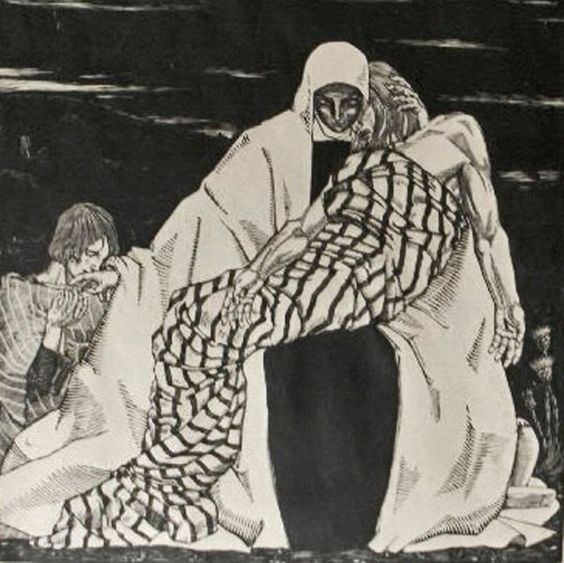
XIII. Jesus is taken down from the cross.
Joseph of Arimethea, a disciple of Jesus – but a secret one, for fear of the Temple authorities – asked Pilate for permission to remove the body of Jesus, and Pilate granted it. So Joseph came and took it away. Nicodemus came as well – the same one who had first come to Jesus by night – and he brought about one hundred pounds of spices, a mixture of myrrh and aloes. They took the body of Jesus and wrapped it with the spices in linen cloths, according to the Jewish burial custom. (John 19:38-40)
In the art history world, there is a long-standing iconography of the Pieta that depicts Mary cradling Jesus after he was taken down from the cross. Perhaps the most famous example is Michaelangelo’s gigantic marble sculpture of the Pieta that is located in St. Peter’s Basilica in Rome. So, as the gospels emphasize that Joseph of Arimethea was courageous in asking Pilate for the body, the reality was that it needed to be done quickly, because the Sabbath was beginning at sunset on Good Friday.
Still, I have to think that Mary was there, when the body was taken down by Joseph of Arimethea. In this image I selected for the thirteenth station, is the classic Pieta composition, but here Jesus is shown, held by Mary, wrapped in a blanket. Usually Pieta artwork shows the broken body of Jesus to emphasize the agony of the violence and devastation, but I can imagine that Mary would be drawn to wrap him in a blanket, just as she had when he was an infant. In this image, Mary embodies the archetype of the Great Mother, grieving for the loss of her son.
What can we wrap around ourselves as we greive our losses, when the unbelievable happens and hope seems to be entirely absent? Where is the click point that we can grab onto so that we are not entirely lost in our excruciating pain?
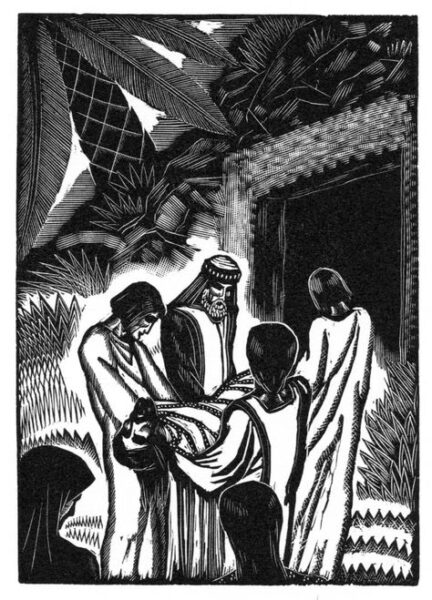
XIV. Jesus is laid in the tomb.
Then, having bought a linen shroud, Joseph took the body of Jesus down, wrapped him in the linen and laid him in a tomb which had been cut out of rock. Finally, he rolled a large stone across the entrance of the tomb. Meanwhile, Mary of Magdala and Mary, the mother of Joses were looking on and observed where Jesus had been laid. (Mark 15:46-47)
As the time of Sabbath was quickly approaching, the body of Jesus was wrapped in linen and laid in the tomb. This burial scene models for us the grace of closure. Going into Holy Saturday, this is the time of silence and stillness and waiting, a time for acceptance of the reality of loss. Just as when Jesus stood before the cross before he was nailed to the cross, this is another moment of threshold. As T.S. Eliot writes, “What we call the beginning is often the end/And to make an end is to make a beginning.” For those who laid Jesus in the tomb and the women who observed the location so they could return after the Sabbath, this is a tentative acceptance of the finality that he is gone.
What are obstacles to acceptance in our broken times, when there is no way to go back to the way it was before? Do we have the strength and hope to recognize the tombs in our lives as thresholds to new life?
UPDATE: This blog post was updated on January 25, 2025 to verify links and to make minor editorial changes.
Readings: The Inclusive New Testament, Priests for Equality, Brentwood, MD, 1994.
Reference 1: Wikipedia, https://en.wikipedia.org/wiki/Stations_of_the_Cross.
Reference 2: Chittister, Joan, “Way of the Cross: Gateway to Resurrection,” Benetvision, Erie, PA, 1999.
Reference 3: Cooke, Rachel, “Eric Gill: Can We Separate the Artist From the Abuser,” The Guardian, April 9, 2017.
Reference 4: Eliot, T.S., “Little Gidding, Part V,” T.S. Eliot: The Complete Poems and Plays 1909-1950, Harcourt, Brace & World, Inc., New York, 1971.
Image 1: Jesus is Condemned to Death, wood engraving by James Reid (1907-1989) for The Life Of Christ In Woodcuts, published by Farrar and Rinehart in 1930.
Image 2: Jesus Picks Up His Cross, print by Jean Charlot (1898-1979,) University of Hawaii, Jean Charlot Collection.
Image 3: Jesus Falls the First Time, engraving by Eric Gill, 1917, photo © Tate Gallery, UK, CC-BY-NC-ND 3.0.
Image 4: Station IV, wood engraving by Bernard Brussel-Smith (1914-1989,) Sacred Art Meditation website.
Image 5: Simon of Cyrene Helps Carry the Cross, woodcut by Jean Marchand, Sacred Art Meditation website.
Image 6: JLVWJ, Julie Lonneman, Womens Stations of the Cross, Fine Art America via Pinterest. Prints can also be purchased at Trinity Stores.
Image 7: Station VII, wood engraving by Bernard Brussel-Smith (1914-1989,) Sacred Art Meditation website.
Image 8: The Carrying of the Cross, engraving by Eric Gill, 1926, photo © Tate Gallery, UK, CC-BY-NC-ND 3.0.
Image 9: Station IX, wood engraving by Pat M. Allman-Smith (1930-2008,) Sacred Art Meditation website.
Image 10: Jesus is Stripped of His Garments, photograph of Tenth Station of the Cross at St. Mary of the Angels Catholic Church, Aldridge, Birmingham, UK, artist unattributed.
Image 11: Jesus is Nailed to the Cross, print by Jean Charlot (1898-1979,) University of Hawaii, Jean Charlot Collection.
Image 12: Crucifixion, wood engraving by James Reid (1907-1989 for The Life of Christ in Woodcuts, published by Farrar and Rinehart in 1930.
Image 13: Christ is Taken Down From the Cross, print by Wiktoria Gorynska, Sacred Art Meditation website.
Image 14: Jesus is Laid in the Tomb, wood engraving by James Reid (1907-1989) for The Life Of Christ In Woodcuts, published by Farrar and Rinehart in 1930.















Leave a Reply
Join the conversation by submitting a comment to this blog post below.